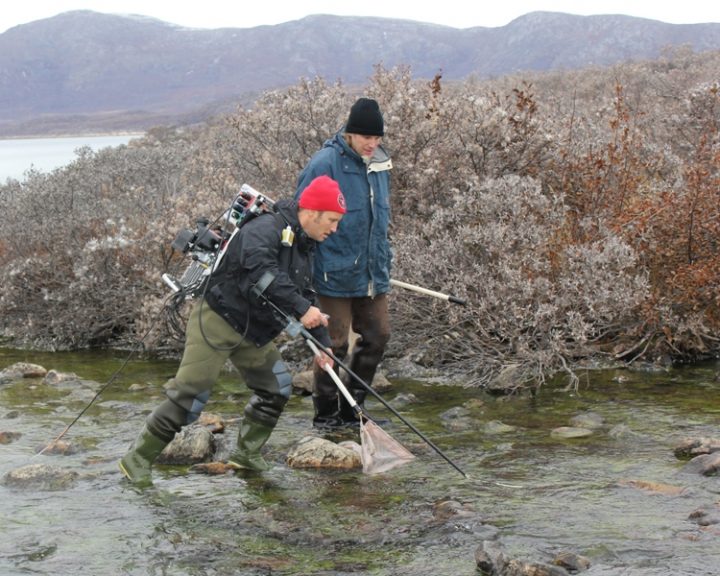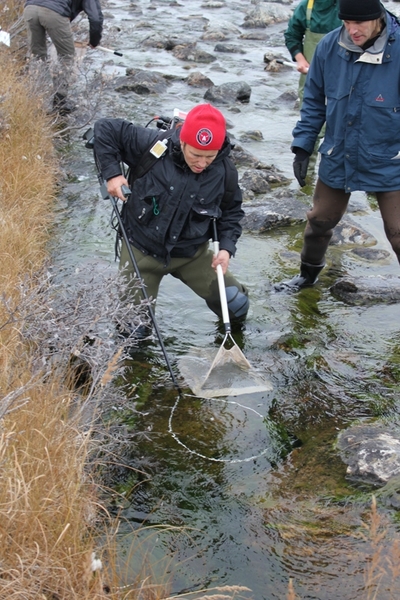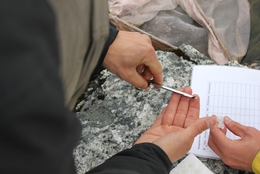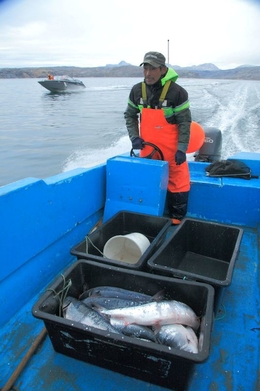Unique salmon population in Kapisillit Published 17.11.2007

The salmon in the Kapisillit River are unique. Genetic studies of the Kapisillit salmon reveal that they live totally isolated from other North Atlantic salmon populations. Measurements also show that they have very few genome variations in comparison to other populations. This is probably because there were very few individuals who managed to colonise the area during a period after the last ice age, and they have since remained isolated from other salmon populations. The Kapisillit River is the only known place in Greenland with a spawning salmon population, and at the request of the inhabitants of the settlement of Kapisillit, the government of Greenland’s environmental authorities are now working on a proposal that could make this an officially protected area.
Jacob Hemmer Hansen from the DTU Aqua Department of Population Ecology and Genetics says: “It’s actually not a surprise that the Kapisillit salmon are different from other salmon populations – but it’s the degree of difference here that’s surprising”. The genetics researcher adds with a smile: “They are uniquely unique, if I may say so”. He also uses the word “dramatic” in his description of the Kapisillit salmon’s genetic material.
Indeed, the Kapisillit salmon have become so genetically distinct partly due to their lifecycle, and partly due to their isolation in an area that is unusual for salmon, where they have adapted to living conditions over the millennia since the last ice age. When salmon are about to spawn, they migrate from the sea back to the very same watercourse where they hatched. In this sense, all salmon populations are genetically unique because they receive very few genetic inputs. In European and North American salmon populations, there are occasionally salmon who “lose their way” and spawn in “foreign” rivers. But since the Kapisillit salmon are Greenland’s only salmon population, this happens very rarely. Furthermore, it’s likely that the relatively few individuals who managed to colonise the area when it was exposed by receding ice 8-10,000 years ago only brought with them a small proportion of the species’ overall genetic variation.
A Greenlandic biology student launched the project
The project was originally launched by a Greenlandic biology student named Kim Andreas Poulsen Krohn, from the University of Southern Denmark. Krohn had a theory that the Kapisillit salmon must be unique, and he set out to document this in his dissertation. Working with local fishermen, he collected approx. 50 large salmon from the river and the fjord near the river’s mouth. Then he contacted the geneticists at DTU Aqua, and from then on the project developed and gained momentum. During the autumn of 2011, the genetic material was supplemented by samples from 54 small salmon from the river that were caught by electrofishing. Finally, it was possible to supplement these samples with a DNA extract from the Greenland Institute of Natural Resources’ archive of salmon scales from 1938 to 1939, which was something of a sensation in its own right. The collected material very clearly shows that the Kapisillit salmon exhibit very little genetic variation in comparison with salmon from Europe and North America – and that they had no genetic inputs after 1938 and are unlikely to have received any prior to that date.
Kapisillit salmon are doing well despite environmental conditions
“Meltwater lakes here in Greenland are generally too cold for newly hatched salmon to survive. In the 1950s, an attempt was made to move Kapisillit salmon to another watercourse at the end of Godthåb Fjord, but without success”, explains Rasmus Hedeholm, a researcher at the Greenland Institute of Natural Resources. “It’s probably thanks to the lake system above the Kapisillit River that this area contains Greenland’s only known spawning salmon population. The meltwater’s time in the lakes gives it a high enough temperature for the salmon to spawn, but the water still remains relatively cold. At the same time, the lakes have a low level of nutrients, which allows the Kapisillit salmon to grow more slowly than populations at other locations and spend more time in freshwater lakes before they migrate out to sea.”
Are the Kapisillit salmon an endangered population?
“We don’t know how large the salmon population in Kapisillit is. But the population is alive and apparently thriving, so it looks as if it’s large enough to avoid any problems associated with inbreeding. On the other hand, it’s so small that it could have difficulties adapting to any future environmental changes, so one would have to say that it’s vulnerable”, according to Jakob Hemmer-Hansen. Rasmus Nygaard, who is also a researcher at the Greenland Institute of Natural Resources, Department of Fish and Shellfish, adds: “We don’t know how many salmon are caught in the inner region of Kapisillit Fjord. Kapisillit salmon have been caught for many years, but they’re still here. One might ask oneself: ‘Why should we consider protecting them in the first place?'” Then he promptly answers his own question:
“Since the Kapisillit salmon are uniquely unique, they constitute an important part of the world’s biodiversity. It’s remarkable that they have even survived for thousands of years since the last ice age. If they disappear, they probably won’t return. If pressure from fishing increases, simultaneously compounded by climate change, then there’s reason for concern. There must be a good reason why local inhabitants have taken the initiative to ask the administration to come up with a plan to protect the fish,” Nygaard concludes.
Written by Kitte Vinter-Jensen, Communication Officer, Pinngortitaleriffik – Greenland Institute of Natural Resources.
- Electrofishing involves using a long electrode to deliver an electric current to the water. This only stuns fish in the direct vicinity of the electrically charged loop. Researchers gather the unconscious fish in a dip net and take a small specimen from their tail fins. The fish are then released again. During the course of an afternoon, they managed to catch 54 small salmon in the river. The fish all completely recovered.
- A small specimen is cut from the tail fin. Very little material is required to extract DNA and conduct a genetic analysis. Researchers from DTU Aqua succeeded, for instance, in extracting DNA from tiny amounts of mucus taken from salmon scales that were gathered in 1938.
- Anthon Mathæussen, a salmon fisherman from Nuuk, has no Kapisillit salmon in his bin. There are so few of them that there is a very low probability of catching them out in the fjord. By contrast, large numbers of salmon from North America and Europe gather in Greenlandic waters to feed and fatten themselves before they return to the watercourses where they hatched. Photo: Audun Rikardson.




